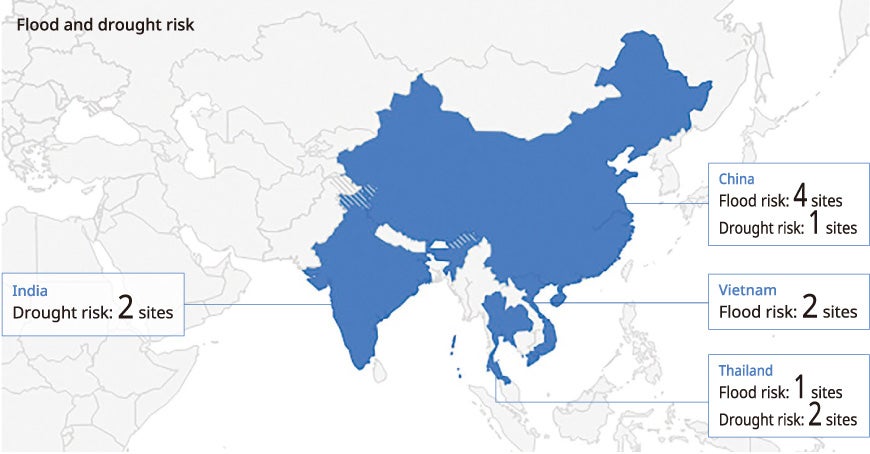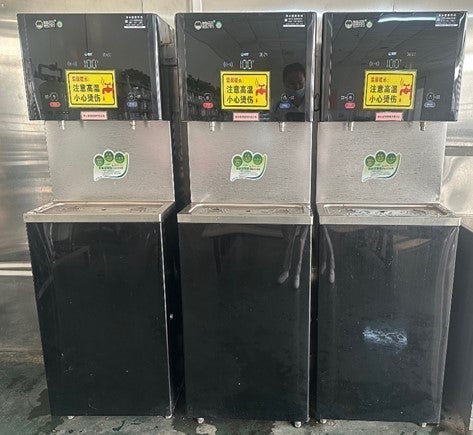Sustainable Resource Use
Water Resource Management
Basic stance
A global business enterprise, the Nidec Group has set targets for water resource and risk management since fiscal year 2004, and has been steadily working to understand water withdrawal and discharge, as well as the impact on surrounding areas and water source regions. We recognize that as our business scale expands, including through M&A, our impact on water resources increases and so does its importance. Going forward, we will continue to promote efficient use of water resources throughout the company, advance efforts to conserve, reuse and recycle water, and work on activities to reduce water risks.
Target
In the Seventh Mid-term Environmental Conservation Plan, we have set a reduction target for water withdrawal and are steadily progressing with specific water risk reduction activities. In addition, we have set "100% implementation of water risk assessment" as one of our materiality KPIs, and will not only grasp the actual situation of water withdrawal and discharge, but also identify water risks in each country and region and evaluate their business impact. Based on the results of this evaluation, we will establish a water risk assessment process to plan and implement risk reduction measures, thereby promoting sustainable water resource management.
The seventh mid-term environmental conservation plan
| Item | Three-year targets (FY2025 goals) |
|---|---|
| Reducing water withdrawal | Reduce emissions by 3% compared to the FY2022 standard by displaying basic units |
| Handle water risks | Complete 100% of water risk assessments |
Materiality: Contribute to environmental sustainability
| Theme to be addressed | KPI (FY2025) |
|---|---|
| Handle water risks | Complete 100% of water risk assessments |
Achievements
Water Withdrawal
Total water withdrawal for fiscal year 2023 will be 8,233,000 m3, a 10.0% reduction per unit of sales compared to fiscal year 2022. As a result of our ongoing efforts to reduce water usage, including water recycling and reuse, we have been able to reduce the amount of water withdrawn and discharged compared to fiscal year 2022.
Water withdrawal by water source, wastewater discharge by destination, and recycled/reused amounts
| Item | Unit | FY2021* | FY2022 | FY2023 | |
|---|---|---|---|---|---|
| Water withdrawal | Total water withdrawal | 1,000 ㎥ | 7,055 | 8,689 | 8,233 |
| Drinking water and industrial water | 1,000 ㎥ | 6,088 | 7,142 | 6,531 | |
| Groundwater | 1,000 ㎥ | 958 | 1,233 | 1,451 | |
| Rivers, ponds, lakes, marshes, rainwater | 1,000 ㎥ | 9 | 316 | 251 | |
| Water discharge | Total water discharge | 1,000 ㎥ | 3,990 | 6,637 | 6,193 |
| Sewage | 1,000 ㎥ | 2,885 | 5,716 | 5,059 | |
| Rivers, ponds, lakes | 1,000 ㎥ | - | 89 | 93 | |
| Sea | 1,000 ㎥ | 1,105 | 832 | 1,041 | |
| Recycled and reused amount | 1,000 ㎥ | 266 | 181 | 450 | |
*Data coverage rate:
FY2021: 53.5%, covering major business bases on Japan, other parts of Asia, and elsewhere
FY2022 and after: 100.0%, covering all business bases (i.e., manufacturing, R&D, sales, and administration bases)
Water risk assessment
The NIDEC Group uses Aqueduct from the World Resources Institute (WRI) and the Water Risk Filter from the World Wide Fund for Nature (WWF) to assess the impact of water risk on business activities at all global production sites. The assessment is based on five key areas - flooding, water scarcity, water quality, water supply fluctuations and regulation/reputation - and aims to accurately understand the impact of water risks on our business. As a result, risk impacts from flooding were confirmed at 38 locations, and risk impacts from water shortages were confirmed at 40 locations, and therefore "flooding" and "water shortages" were identified as major risks for our company. Furthermore, after conducting detailed investigations of local information and business activities, we determined that a total of 12 locations - five in China, three in Thailand, two in Vietnam, and two in India - were at high risk of flooding and water shortages. We have confirmed that certain measures to reduce risk have already been taken at these locations.

Business impact of water risk (flood risk)
The NIDEC Group uses Aqueduct, a water risk analysis tool provided by the World Resources Institute (WRI), to understand the impact on its business and implement appropriate measures. Using this tool, we conducted a detailed assessment of the impact if all 38 locations assessed as being at high risk of flooding were to be hit by a disaster. In addition, based on the Ministry of Land, Infrastructure, Transport and Tourism's "Guidelines for Assessing Physical Risks in the TCFD Recommendations," the company calculated the impact of damage to fixed assets and inventory, as well as opportunity losses due to operational suspension, and assessed the financial impact to be 42.2 billion yen.
| Risk | Financial impact |
|---|---|
| Flooding-caused damage | 42.2 billion yen |
Understanding water usage in water stressed (water shortage) areas
In water-stressed regions where water shortages could affect our business, we manage annual trends in water usage separately. The five sites exposed to water risks are China (1 site), Thailand (2 sites), and India (2 sites), with a total water withdrawal volume of 949,000 m3 in fiscal year 2023. This is equivalent to 12% of the NIDEC Group's water withdrawal volume in fiscal year 2023.
Water use of regions under water stress (water shortage)
| Section | Unit | FY2022 | FY2023 |
|---|---|---|---|
| Water withdrawal | 1,000㎥ | 1,100 | 949 |
| Water discharge | 1,000㎥ | 996 | 842 |
| Amount of water recycled and reused |
1,000㎥ | 101 | 125 |
Research and development costs to mitigate water-related risks
NIDEC has invested 18 million yen in fiscal year 2023 as investment in research and development to reduce water-related risks.
Research and development costs to mitigate water-related risks in FY2023
| Item | Cost amount (million yen) |
|---|---|
| Research and development costs to mitigate water-related risks | 18 |
Water-related legal violation
Throughout fiscal year 2023, NIDEC did not experience any water-related environmental accidents or legal or regulatory violations requiring emergency response at any of its domestic or overseas business locations.
Actions
To counter flooding-related risks, we analyze their impact on our businesses deeply, while promoting risk-mitigating actions. To address water shortage-related risks, we are enhancing our water withdrawal and discharge management of water-stressed regions (those prone to water shortage), while reducing water usage by 1% per year company-wide, expressed in unit consumption. Furthermore, we continue to manage individual elements related to water usage, to detect business-disrupting factors early, and counter them properly. Nidec has in place emergency risk measures for the production bases in these water-stressed regions by, for example, monitoring the water levels of rivers and installing wells to secure a necessary amount of water. Additionally, we collect information on improvements and actions for water management, and share the information group-wide, to better manage our water resources and minimize water-related risks.
Water reuse and recycle
Nidec Precision (Zhejiang) is actively working to reuse and recycle water with the water reuse and recycling rate exceeding 60% of the total amount used in FY2023
Water recycling flow in the cleaning process

Efficient water use
In its cooling tower with the highest water use, Nidec Power Train Systems’ production base in Zhejiang, China thoroughly managed the temperatures in its chiller, cooling tower, and air-handling unit, and suppressed water evaporation, to reduce its FY2023 water intake by 17.6% from the level of the prior fiscal year.
Upgrading equipment for more efficient use of water
By introducing water-saving water servers, Nidec Instruments (Zhejiang) Corporation successfully reduced its FY2023 water intake by 2.86% from the level of the prior fiscal year.

